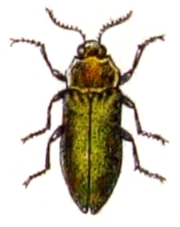Agrilus hyperici
| Agrilus hyperici | |
|---|---|

| |
| Scientific classification | |
| Domain: | Eukaryota |
| Kingdom: | Animalia |
| Phylum: | Arthropoda |
| Class: | Insecta |
| Order: | Coleoptera |
| Family: | Buprestidae |
| Genus: | Agrilus |
| Species: | A. hyperici
|
| Binomial name | |
| Agrilus hyperici Creutzer
| |
Agrilus hyperici is a species of jewel beetle known by the common name St. John's wort root borer. It is used as an agent of biological pest control against the noxious weed known as common St. John's wort (Hypericum perforatum).
The adult beetle is narrow and elongated, reddish-brown in color and about 5 millimeters in length. The female deposits eggs low on the stem of the St. John's wort plant during the summer months. The larva emerges from the egg and makes its way to the roots where it feeds on root tissue for nearly a year. Often the larvae consume nearly all the roots on a plant and then pupate inside the remnants. Few plants survive attack by this species. The beetle is known to attack the similar plant goldwire (Hypericum concinnum) in California, but it does not appear to have a destructive impact on this species.
This beetle is native to Europe. Its association with the St. John's wort plant has been known for a long time and it was first introduced to the United States for the purposes of biocontrol in 1950, in California. It is now established in much of the northwestern United States, especially in mountainous areas, and in Australia.
References
- Coombs, E. M., et al., Eds. (2004). Biological Control of Invasive Plants in the United States. Corvallis: Oregon State University Press, 324.
